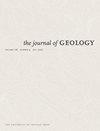Late Paleozoic to Early Mesozoic Evolution of Neo-Tethys: Geochemical Evidence from Early Triassic Mafic Intrusive Rocks in the Tethyan Himalaya
IF 1.3
4区 地球科学
Q2 GEOLOGY
引用次数: 0
Abstract
Here we report geochronological, geochemical, and Sr-Nd-Hf isotopic data of a basic intrusion exposed in the Jiacha area within the Tethyan Himalaya, southern Tibet. The Jiacha dikes are composed mainly of mafic rocks (gabbros). In zircon U-Pb dating of Jiacha dikes samples, the weighted mean ages of magma emplacement were determined to be 241.5±4.2 to 245.5±3.3 Ma, showing a Middle Triassic magmatic event in the eastern part of the Tethyan Himalaya. The Jiacha dikes have relatively low MgO and total alkali (K2O+Na2O) contents but high TiO2 contents, exhibit weakly fractionated rare earth element (REE) patterns with slight depletions in light REEs and no obvious Eu anomalies, and show enrichment in high field strength elements and depletion in large-ion lithophile elements. Their initial 87Sr/86Sr ratios vary in the range 0.704250–0.704321, with a positive εNd(t = 243 Ma) of +3.07 to +3.67, and their initial 176Hf/177Hf ratios vary in the range 0.282872–0.283044, with a positive εHf(t = 243 Ma) of +8.53 to +14.45. We propose that the Jiacha dikes were derived from spinel lherzolites in the mantle with no crustal contamination and underwent fractional crystallization of clinopyroxene. Considering previous studies, we propose that Jiacha dikes represent oceanic crustal products of the early evolution of the Neo-Tethys, indicating that the ocean had already begun to open in the Middle Triassic.新特提斯晚古生代至早中生代演化——来自特提斯喜马拉雅早三叠世黑手党侵入岩的地球化学证据
在这里,我们报道了西藏南部特提斯喜马拉雅加查地区暴露的一个基性侵入体的地质年代、地球化学和Sr-Nd-Hf同位素数据。夹岔岩墙主要由镁铁质岩石(辉长岩)组成。在加茶岩脉锆石U-Pb测年中,确定了岩浆侵位的加权平均年龄为241.5±4.2~245.5±3.3Ma,表明特提斯喜马拉雅东部存在中三叠世岩浆活动。夹岔脉MgO和总碱(K2O+Na2O)含量相对较低,但TiO2含量较高,表现出弱分馏稀土元素(REE)模式,轻稀土元素略有贫化,Eu异常不明显,高场强元素富集,大离子亲石元素贫化。它们的初始87Sr/86Sr比值在0.704250–0.704321之间变化,正εNd(t=243 Ma)为+3.07至+3.67,其初始176Hf/177Hf比值在0.282872–0.283044之间变化,负εHf(t=243 Ma)为+8.53至+14.45。我们认为夹茶岩脉是由地幔中的尖晶石二辉橄榄岩衍生而来,没有地壳污染,并经历了单斜辉石的分步结晶。结合前人的研究,我们认为夹茶海堤代表了新三叠世早期演化的海洋地壳产物,表明海洋在中三叠世已经开始张开。
本文章由计算机程序翻译,如有差异,请以英文原文为准。
求助全文
约1分钟内获得全文
求助全文
来源期刊

Journal of Geology
地学-地质学
CiteScore
3.50
自引率
5.60%
发文量
0
审稿时长
3 months
期刊介绍:
One of the oldest journals in geology, The Journal of Geology has since 1893 promoted the systematic philosophical and fundamental study of geology.
The Journal publishes original research across a broad range of subfields in geology, including geophysics, geochemistry, sedimentology, geomorphology, petrology, plate tectonics, volcanology, structural geology, mineralogy, and planetary sciences. Many of its articles have wide appeal for geologists, present research of topical relevance, and offer new geological insights through the application of innovative approaches and methods.
 求助内容:
求助内容: 应助结果提醒方式:
应助结果提醒方式:


